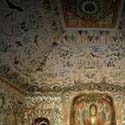|
|
| Show All 27 Results (Text Only) |
|
| Museum Collections of Silk Road Art |
|
| University of Washington, Simpson Center for the Humanities
|
"[A]nnotated descriptions of and links to the websites of major art museums exhibiting objects of interest for the study of the Silk Road" from the University of Washington's Silk Road Seattle, "an ongoing public education project using the 'Silk Road' theme to explore cultural interaction across Eurasia from the beginning of the Common Era (A. D.) to the Seventeenth Century."
Go to Museum Resource: http://depts.washington.edu/silkroad/museums/srmuseums.html | |
|
|
| Playing with Shadows: An Introduction to Shadow Puppetry |
|
| The Kennedy Center, ArtsEdge
|
"Discover the secrets behind the art of shadow puppetry in this multimedia exploration, designed for grades 5-8, which explores this age-old art form through animations, videos, interactive activities, and more." With questions for discussion and two related lesson plans (see left-hand column): "Puppets on the Move: China and the Silk Road" and "Shadows & Light, Science & Puppetry." Uses Flash.
Go to Museum Resource: https://artsedge.kennedy-center.org/multimedia/series/AEMicrosites/playing-with... | |
|
|
| Puppets on the Move: China and the Silk Road |
|
| The Kennedy Center, ArtsEdge
|
This lesson is part of the unit: 'Teaching Shadow Puppetry.' Through map-making, research, and class discussions, students will gain an understanding of the dynamics of trade in China along the Silk Road and the role of trade in urbanization throughout the Han, Tang, and Song dynasties. The lesson will culminate in student-produced and student-created shadow puppet performances that demonstrate students’ understanding of Chinese culture during the days of the Silk Road and of the connection between trade and urbanization.
Go to Museum Resource: https://artsedge.kennedy-center.org/educators/lessons/grade-6-8/Puppets_on_the_... | |
|
|
| Silk Road Encounters: The Music of Strangers |
|
| The Silk Road Project
|
"As a symbol of the crossroads between civilizations, peoples, and cultures, the Silk Roads offer rich materials for students to explore diverse but inter-related topics on geography, trade, art, music, religion, and history." Includes several on-line video lessons plus a curriculum guide meant to accompany the film of the same name. See also: Curriculum Guide [PDF].
Go to Museum Resource: https://www.silkroad.org/resources-tmos | |
|
|
| The Silk Road [PDF] |
|
| Pacific Asia Museum of USC
|
Lesson plan designed for grade 6, focusing on preparing students to explore works of Asian art. “Enduring Questions: How did societies interact with each other? How did connections between societies increase over time? How did the establishment of the Silk Road increase trade, the spread of Buddhism, and the connections between China and other regions of Afro - Eurasia?”
Go to Museum Resource: https://pacificasiamuseum.usc.edu/files/2019/03/USC-PAM-My-Masterpieces-Curricu... | |
|
|
| The Silk Roads in History |
|
| University of Pennsylvania Museum of Archaeology and Anthropology
|
“There is an endless popular fascination with the “Silk Roads,” the historic routes of economic and cultural exchange across Eurasia. The phrase in our own time has been used as a metaphor for Central Asian oil pipelines, and it it common advertising copy for the romantic exoticism of expensive adventure travel. One would think that, in the century and a third since the German geographer Ferdinand von Richthofen coined the term to describe what for him was a quite specific route of east-west trade some 2,000 years ago, there might be some consensus as to what and when the Silk Roads were. Yet, as the Penn Museum exhibition of Silk Road artifacts demonstrates, we are still learning about that history, and many aspects of it are subject to vigorous scholarly debate.” An excellent rich site on the Silk Roads.
Go to Museum Resource: https://www.penn.museum/sites/expedition/the-silk-roads-in-history/ | |
|
|
| The Spread of Buddhism Across Asia |
|
| Asian Art Museum of San Francisco
|
Understand, through the analysis of artifacts and maps, how Buddhism changed as it spread across Asia and came to reflect the countries that embraced it. Downloads include a slideshow and handout on Buddhist artifacts and a lesson plan.
Go to Museum Resource: https://education.asianart.org/resources/the-spread-of-buddhism-across-asia/ | |
|
|
| Traveling the Silk Road: Educator's Guide |
|
| American Museum of Natural History
|
Online educator's guide to the 2010 exhibition at the AMNH that takes visitors "along the world's oldest international highway, on a voyage that spans six centuries (AD 600 to 1200). (The exhibition) showcases four representative cities: Xi'an, China's Tang Dynasty capital; Turfan, a bustling oasis; Samarkand, home of prosperous merchants; and Baghdad, a meeting place for scholars, scientists, and philosophers." Featuring activities for grades 3-5, 6-8, and 9-12, standards correlations, map, glossary, and more.
Go to Museum Resource: https://www.amnh.org/exhibitions/traveling-the-silk-road/educator-resources | |
|
|
|
| Show All 27 Results (Text Only) |








